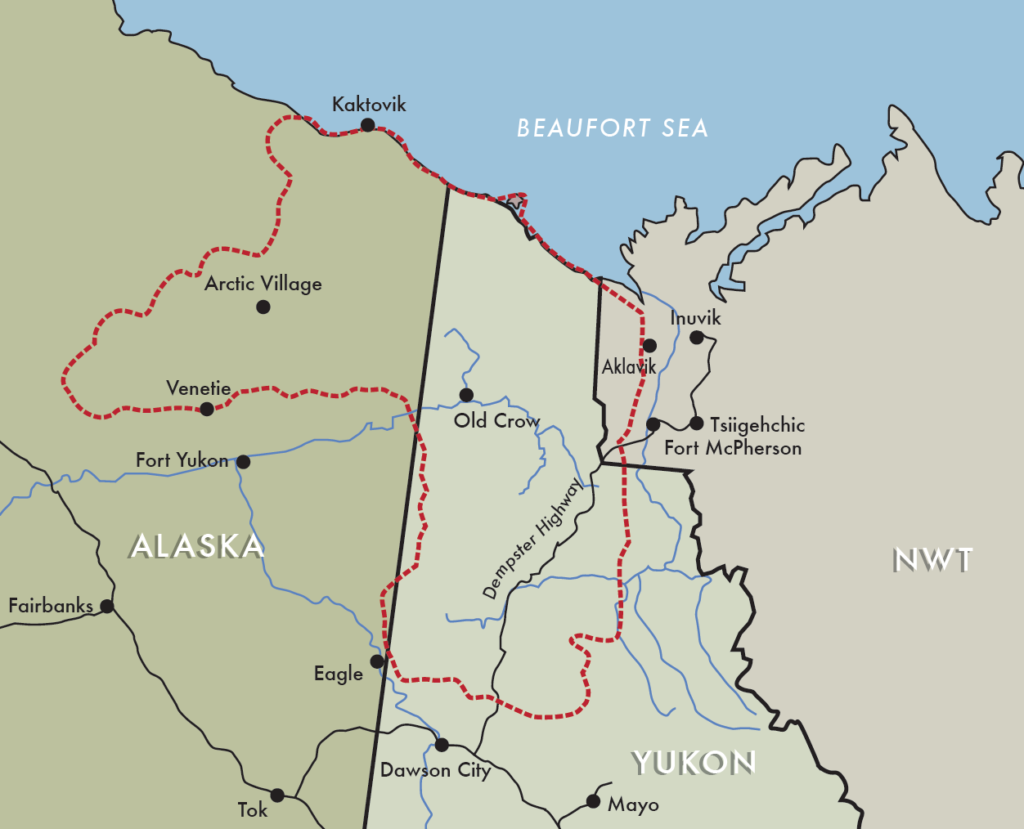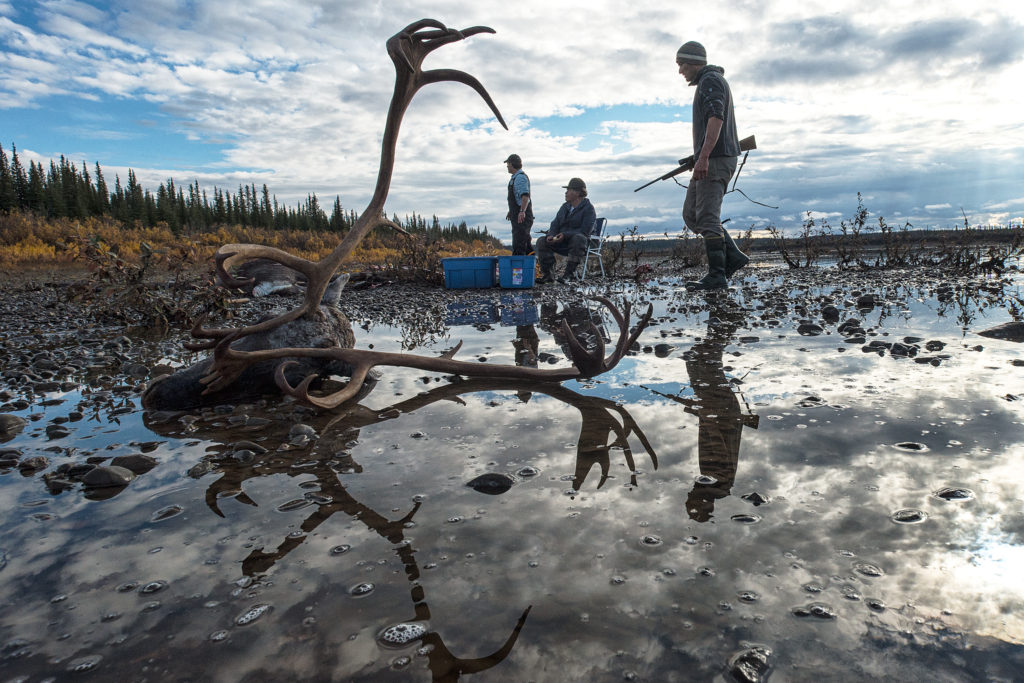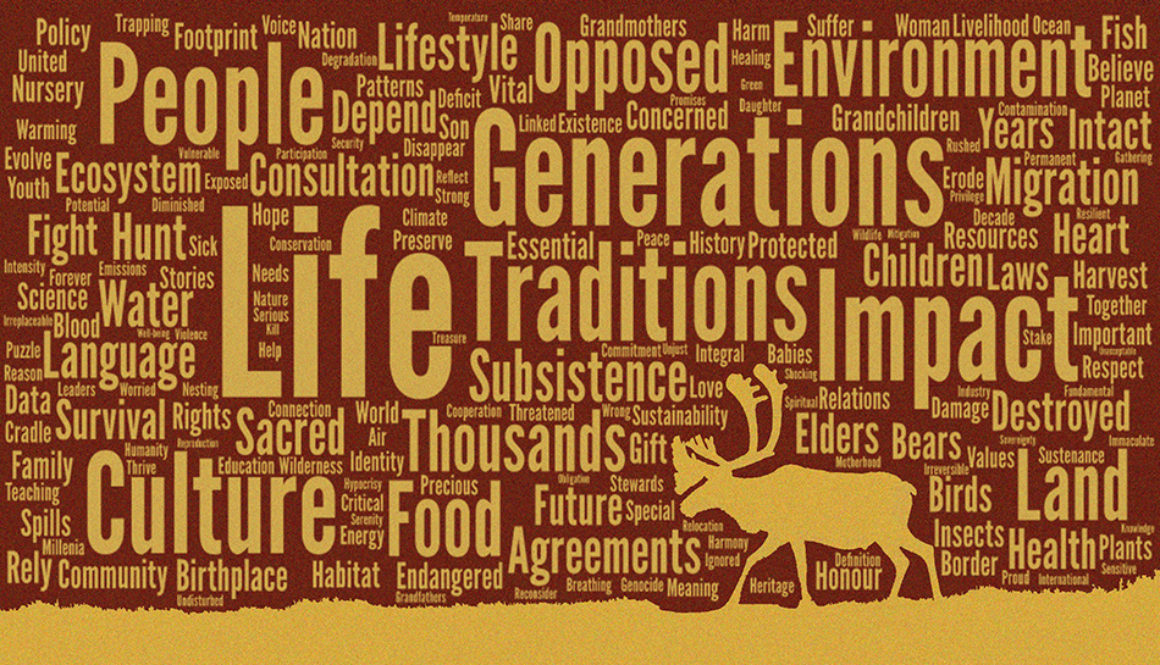What We Heard: Canadian Perspectives on Drilling in the Arctic Refuge
Header Image: Keywords pulled from hearing statements and letters of those opposed to drilling in the Arctic Refuge during the EIS process. Word size is based on the frequency that word was used. Designed by Braden Lamoureux, Photo by Malkolm Boothroyd
Written by: Braden Lamoureux, Conservation and Events Intern
Over 50% of the Porcupine caribou’s migratory habitat lies within Canadian borders. Yet their critical breeding grounds on the coastal plains lie within U.S. borders and are at risk of being drilled for oil and gas. And it’s not just the caribou. Hundreds of migrating bird species, polar bears looking for their winter dens, and Arctic foxes roam freely through their natural habitat ranges with no regard for human-made borders. Conserving these transboundary species involves cooperation and consultation between countries. So far, the U.S. Bureau of Land Management (BLM) has been neglecting engagement with Canadians.
“Caribou don’t cross the border with passports, they just walk by the thousands.”
– Paul Davis, Whitehorse
Yukon and Vuntut Gwitchin citizens were both denied the opportunity to voice their concerns for the Arctic Refuge when they requested that the BLM hold hearings in Canada. Public hearings were held in eight U.S. locations during the commenting period of the Draft Environmental Impact Statement (Draft EIS), but none in Canada. The disturbing effects of drilling in the Arctic Refuge would primarily affect Yukoners, yet the Draft EIS fails to recognize and address many of the impacts this project will have on Canadians.

“The failure of your program [BLM] to consult in the Yukon is a shocking weakness. The Porcupine Caribou herd is Canada’s as much as it is Alaska’s. We have a stake and we should be better involved. “
– David Loeks, Whitehorse
Many powerful and personal stories from the Canadian side of the border were put on the public record during the scoping and EIS commenting periods of the project’s environmental assessment. Since the BLM isn’t doing such a good job of listening, I have compiled some of the key concerns with drilling in the Arctic Refuge. We could call it a mini ‘What We Heard Report’ from the Canadian perspective. It is important to hear these voices from those most affected by this issue to understand the critical subsistence value that comes from such a place like Izhik Gwats’an Gwandaii Goodlit — “the sacred place where life begins”. The Gwich’in name for the coastal plains.
The top 10 keywords that appeared most frequently in scoping and commenting responses opposed to drilling in the Arctic Refuge are: Life, Generations, Impact, Culture, Traditions, Environment, Food, Thousands, Subsistence, and Agreements.
A recurring theme that appeared over and over again was the tremendous value that is placed in the Porcupine caribou herd. Hunting caribou was described not only as a way of life, but the source of life itself. In northern Canada, equitable food access is a huge issue due to the challenge of growing or importing food to fly-in communities. One such example is the community of Old Crow, Yukon, where the weekly cost of groceries for a family of four is over $500. For the Gwich’in, the Porcupine caribou are their food security. If oil and gas drilling causes a decline in the caribou population, then the quality of affordable food, housing, and health benefits also dwindles with them.
Letters from Canadian environmental organizations and biologists highlighted the ecological importance of the coastal plains to migratory shore birds, marine fish, sensitive Arctic flora, and of course, breeding caribou. Canadian scientists that have been monitoring the Arctic Refuge for decades recognize its crucial role as an area of resilience…and quite literally a refuge for wildlife.

But even more powerful of a testimony, is the cultural importance that the caribou holds in Gwich’in and Northern Canadian identity. For thousands of years, the Gwich’in have harvested caribou responsibly from the land. This relationship is a history of intimacy and kinship, as Maureen Charlie from Old Crow said; ‘The herd’s hardship is a trait us Gwitchin value, the herd’s survival is as important to us as our own’. When the caribou suffer, so do the Gwich’in citizens that are still healing as a culture from colonization. Some suggested that drilling in the Arctic Refuge is a direct continuation of this cultural genocide.
Some of the comments reminded us of the U.N. Declaration on the Rights of Indigenous Peoples (UNDRIP) which was endorsed by the U.S. in 2010. This declaration sets an international standard that aboriginal people have the right to the conservation of their traditional medicinal plants, animals and minerals (Article 24), as well as the maintenance of their spiritual relationship to their traditional territories and resources for future generations (Article 25). Others are concerned for the loss of language, education, and traditional knowledge that is passed down through generations of oral history. The children and grandchildren of Gwich’in elders, who have been eating caribou since childhood, now face an uncertain future on the land if the caribou disappear. Just as we try to see every environmental and economic issue through the lens of climate change, the Gwich’in must also approach issues from this additional angle. The caribou are linked to many of the same topics – health, housing, economic growth, education, food security, jobs, culture, and more.
All of these things will surely depreciate with the health of the Porcupine caribou herd if drilling occurs in the Arctic Refuge.

